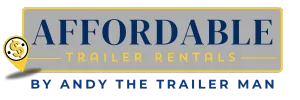Have a Question? Give us a Call...
Our Trailer Rental Resources

How To Hook Up A Trailer
"A trailer may not pull itself—but with the right hook-up, you’re halfway to freedom!"
Introduction
Hooking up a bumper pull trailer may seem intimidating at first, especially if you're new to towing. But once you understand the process and follow a repeatable system, it becomes second nature. In this guide, we’ll walk you through how to safely and correctly hook up a bumper pull trailer so you can tow with confidence.
Whether you’re hauling equipment, moving furniture, or heading out on an adventure, this guide is for you.

What is a Bumper Pull Trailer?
A bumper pull trailer, also known as a tag-along trailer, is a type of trailer that hitches onto the rear receiver hitch of your tow vehicle. It’s the most common trailer type used by homeowners, DIYers, and small business owners.
Equipment You'll Need
Before you begin, gather the following essentials:
Hitch receiver (installed on your tow vehicle)
Ball mount and hitch ball
Trailer coupler
Safety chains
Electrical wiring harness
Wheel chocks
Trailer jack
Step-by-Step Guide: How to Hook Up a Bumper Pull Trailer
1. Park on Level Ground
Start by parking your tow vehicle and trailer on a level surface. Engage the parking brake. Use wheel chocks to prevent the trailer from rolling.
2. Inspect Your Equipment
Ensure the hitch ball and coupler are compatible and properly rated for the trailer’s weight. Check that the trailer jack works smoothly and the safety chains are in good condition.
3. Align the Vehicle and Trailer
Back your tow vehicle up so that the hitch ball lines up directly under the trailer coupler. Use a spotter or backup camera for easier alignment.
4. Lower the Coupler Onto the Hitch Ball
Use the trailer jack to lower the coupler onto the ball. Once it’s fully seated, secure the latch mechanism and insert a coupler pin or lock.
5. Attach the Safety Chains
Cross the safety chains underneath the trailer tongue and attach them to the hitch loops on the tow vehicle. The chains should form an “X” underneath the hitch.
6. Connect the Electrical Plug
Plug the trailer’s wiring harness into the tow vehicle’s electrical outlet. Test the lights (brake lights, turn signals, running lights) before you hit the road.
7. Raise the Trailer Jack
Fully raise the trailer jack and lock it in place. Make sure it won’t drag or hit any bumps on the road.
8. Final Inspection
Double-check everything: hitch connection, safety chains, lights, and trailer load. Tug gently forward to ensure the trailer is locked in place.
Safety Tips
Always cross your safety chains.
Never tow a trailer that exceeds your vehicle’s tow capacity.
Perform a pre-trip inspection every time.
Carry a tire pressure gauge and a lug wrench.
Practice driving with your trailer in an empty parking lot before heading into traffic.
FAQs
Q: Can I hook up a trailer by myself?
Yes, but using a backup camera or having a spotter helps. Just go slow and check every connection twice.
Q: Do I need a special license to tow a bumper pull trailer?
In most states, you do not need a special license if the trailer is under a certain weight (usually under 10,000 lbs). Always check local laws.
Q: What size hitch ball do I need?
Common sizes are 1-7/8", 2", and 2-5/16". Match your trailer coupler to the correct ball size.
Q: What’s the difference between a bumper pull and a gooseneck trailer?
A bumper pull connects to a rear hitch; a gooseneck connects in the bed of a truck and is used for heavier loads.
Conclusion
Hooking up a bumper pull trailer becomes easier with repetition and confidence. By following the steps outlined in this guide, you’ll be ready to hit the road safely. Whether you're towing for business or pleasure, taking the time to do it right keeps you and others safe.
If you found this guide helpful, share it with someone who’s just starting out. Happy towing!
Office: Callahan, Florida
Call (904) 892-8919
Email: [email protected]
Site: www.affordabletrailerrentals.net

